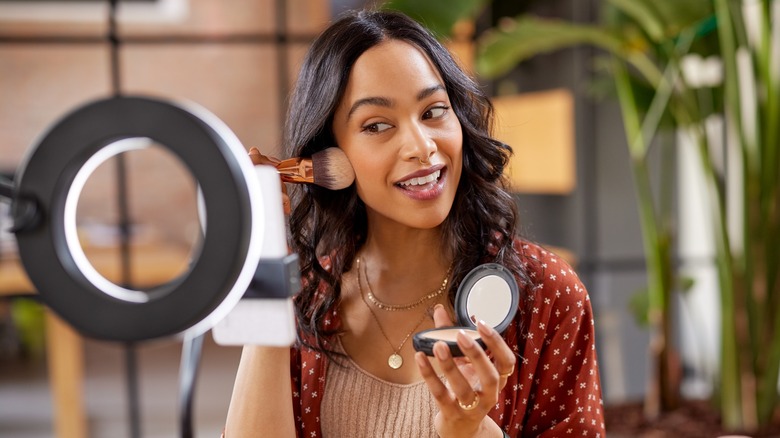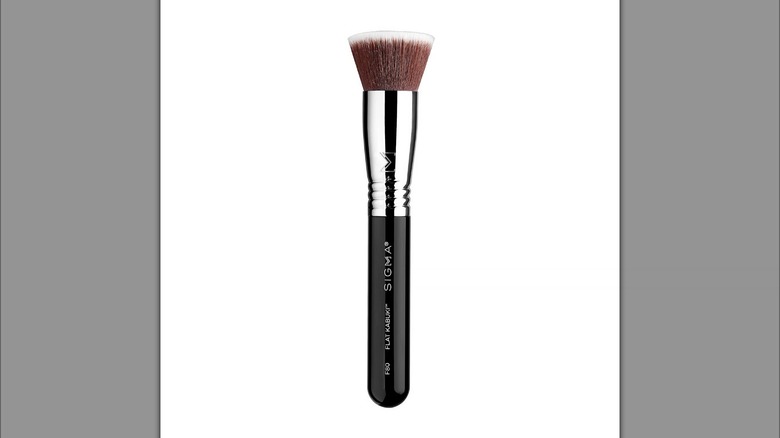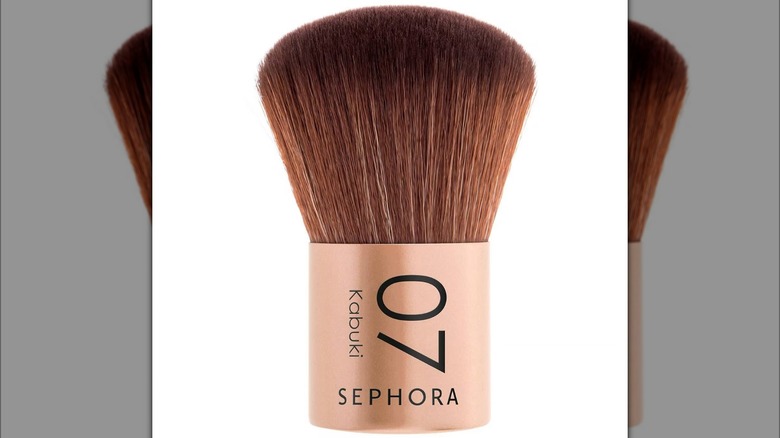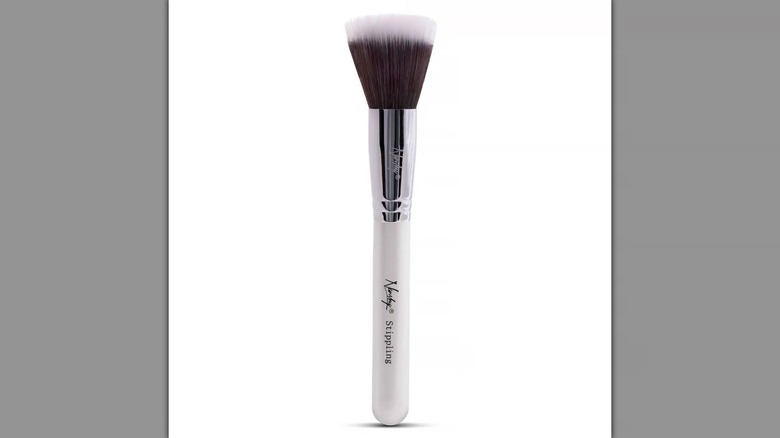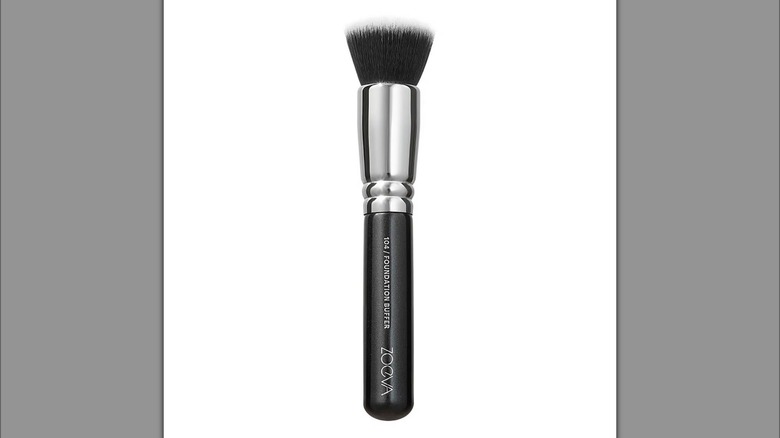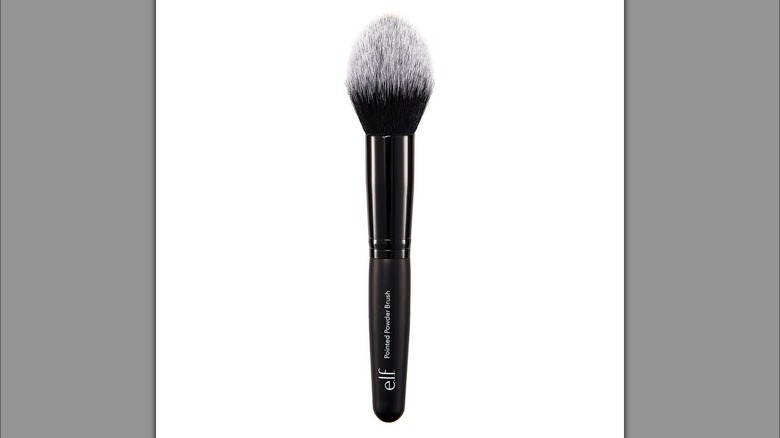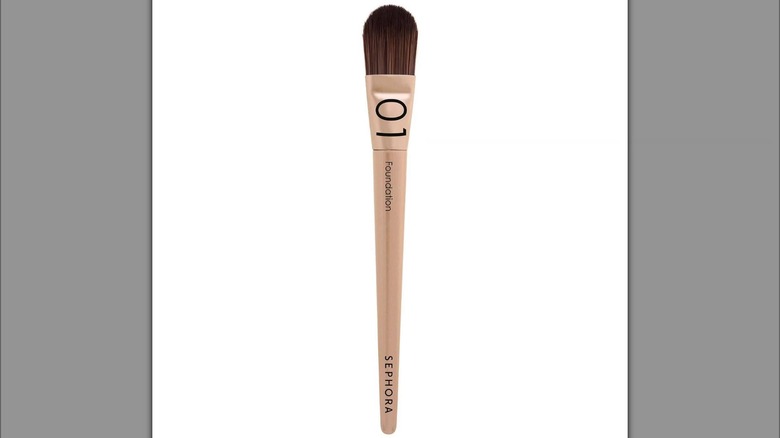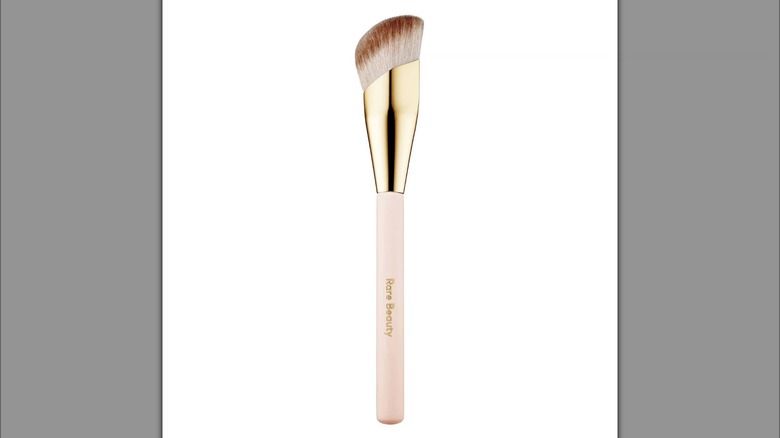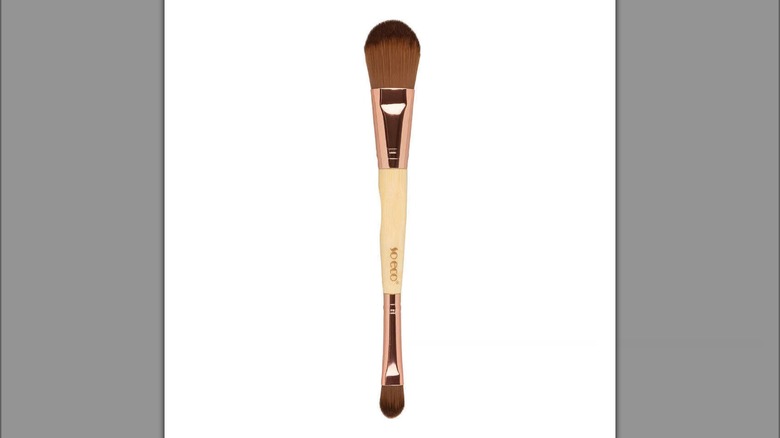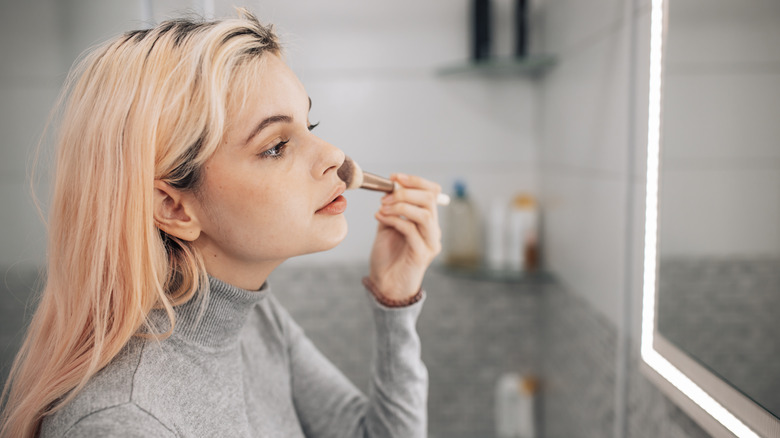The Shape Of Your Foundation Brush Determines Your Coverage - Here's What To Know
Foundation brushes. It seems like there are SO many different shapes and styles out there, and it can be totally overwhelming to try and workout which one will actually work for you. But, though it seems tempting to just apply with fingers or a sponge, there's a reason why brushes are long considered tried-and-true when it comes to foundation. "Brushes give you a lovely, buffed finish that you just can't get with fingertips," celebrity makeup artist and Bakeup Beauty co-founder Jo Baker explained to Marie Claire. "A seamless filter finish can only be created using brushes."
When picking out a foundation brush, there are two key things to consider: the kind of coverage you want and the finish. "Tapered bristles provide maximum product pick-up and lay-down for a fuller coverage, while dense, domed bristles buff liquids and cream foundations," Sofia Alfano, brand manager at Real Techniques, explained to Live That Glow. With that in mind, let's go over the different styles of foundation brushes and what kind of coverage you can expect from each.
A flat Kabuki brush will give you a full coverage finish
If you're going for a flawless, full-coverage look, reach for a firm Kabuki-style brush. These brushes tend to be densely packed with flat topped bristles on a short handle. These will give you heavier coverage because of how much product they can pick up. "A Kabuki brush makes achieving even foundation coverage much easier," makeup artist Amy Saunders explained to Green People. "The short handle gives so much more control when you blend, and the dome shape makes it easy to work mineral makeup over the contours of the face and around tricky areas such as the nose." Though you can use a liquid foundation with a Kabuki, Sofia Alfano told Live That Glow it's particularly good with a powder formula because it can easily be used to lift and press the powder into your skin. For this reason, it can be a great option for those with oily skin.
A curved Kabuki brush will deliver more of a medium coverage
Moving away from the flat top Kabuki brush, a curved or tapered Kabuki with curved bristles will pick up slightly less product, resulting a look closer to a medium coverage. While the flat brush is better for use with either liquid or powder foundation, this version is better used with a powder foundation because it's not designed to pick up quite so much product. One of the big pros though is that Kabuki brushes tend to be larger than other foundation brushes, meaning you can cover a big surface area in a relatively small amount of time. Perfect for those who don't have hours to do their makeup.
A stippling brush is also great for achieving full coverage
When using a stippling brush, you apply product in small, circular motions, to get that flawlessly smooth and streak-free finish. Its different length bristles serve multiple purposes — to carry the product and then tap it on the skin, resulting in a finish similar to that of buffing brushes. This enables you to create buildable coverage up to a full-coverage look, which can be great for those who have blemishes or discoloration they want to cover without looking cakey. That makes this brush a strong choice if you like to change your coverage depending on what's in or change it up with the seasons. "I suggest using a liquid foundation or cream foundation as they work best for building the coverage," celebrity makeup artist Billie Gene told Makeup.com.
A large, hard bristled brush can give you full coverage quickly
If you don't have too much time to get your makeup on in the morning but you still want a totally even finish, you may want to try a large, hard bristled brush. "I like to use a compact, hard bristled brush with powder foundation as this brush picks up the most product," L'Oréal makeup expert Gabriel Almodovar told Makeup.com. However, some may find that because of the dense, harder bristles it can be difficult to get an even application or reach every single centimeter of the face.
A basic powder brush works for light foundation coverage
If you don't want to head out and buy (yet another) makeup tool, the powder brush you already have in your arsenal could actually double as a great light coverage foundation brush. Makeup expert Gabriel Almodovar shared this tip with Makeup.com, explaining he uses this tool when he doesn't want to put too much foundation on his clients. That's because powder brushes tend to have finer bristles designed to pick up less product so as not to make the face look dry and cakey. This can be a great option for those who don't require full coverage and just want a slightly more even tone on their face. But for those who want to cover large areas of blemishes or discoloration, this may not be the brush to pick up.
A classic flat brush will give you the best of both worlds
When people think of a foundation brush, this is the shape most people probably think of: A long, paintbrush-like handle with a flat, paddle-like rounded edge at the top. That's probably because this is one of the most versatile types of foundation brushes due to the fact it allows for more precise application. "[They] offer buildable coverage, so you can really control whether you want a sheer application of the product or want to build up to fuller coverage in certain areas," celebrity makeup artist Melissa Murdick explained to Marie Claire. These brushes tend to work best with cream or liquid foundations though, not powder, and can be used to almost paint the makeup onto your skin.
A slanted foundation brush can be useful for getting to those hard-to-reach places
If you find you struggle to get your foundation everywhere you need it on the face, an angled foundation brush could be for you. The slanted bristles allow you to get into those more awkward nooks and crannies, such as around the nose or the jawline. How much coverage you can get with a slanted brush will depend on the density of the bristles and how lightly you use it for application, though slanted brushes can be great for building up coverage or adding a little extra product only in the areas you need it. Ideal for those with blemishes or discoloration in certain areas of the face.
While a double-sided foundation brush can also be useful for those awkward spots on the face
A double-sided foundation brush can also be super useful for those harder to get to parts of the face. These brushes tend to have a larger, more fanned out side for use on the majority of the face, and then a smaller, more angular side for those awkward areas. Getting a dual-ended foundation brush like this one will give you the best of both worlds, as you'll be able to get a flawless application on the skin in a quick fashion, but then go into the parts it wasn't quite able to get using the slightly smaller side. In most cases, the smaller side will allow you to build up more coverage, as you can get more precise in a specific area, giving you full coverage only in the areas you need it for a more natural foundation look.
But don't forget to think about the bristles too!
When it comes to foundation coverage, it's not just the shape of the tools that matter. You'll also want to keep in mind that the type of bristles will make a difference in the finish you achieve. There are three options when it comes to bristles: Synthetic (which are usually made of nylons and plastics), natural (which tends to be derived from animal hairs), and a hybrid mix of the two. Typically, a synthetic bristle brush will give you a more even finish as natural brushes tend to soak up more product.
"When I am working with a product that needs more of a push to blend (cream or full coverage foundations and large domed 'airbrush effect' brushes); I tend to prefer synthetic brushes for their dense and even application and because they last better after washing those products out," celebrity makeup artist Bob Scott explained to Teen Vogue. Though he doesn't recommend natural foundation brushes for anything but powder foundations.
